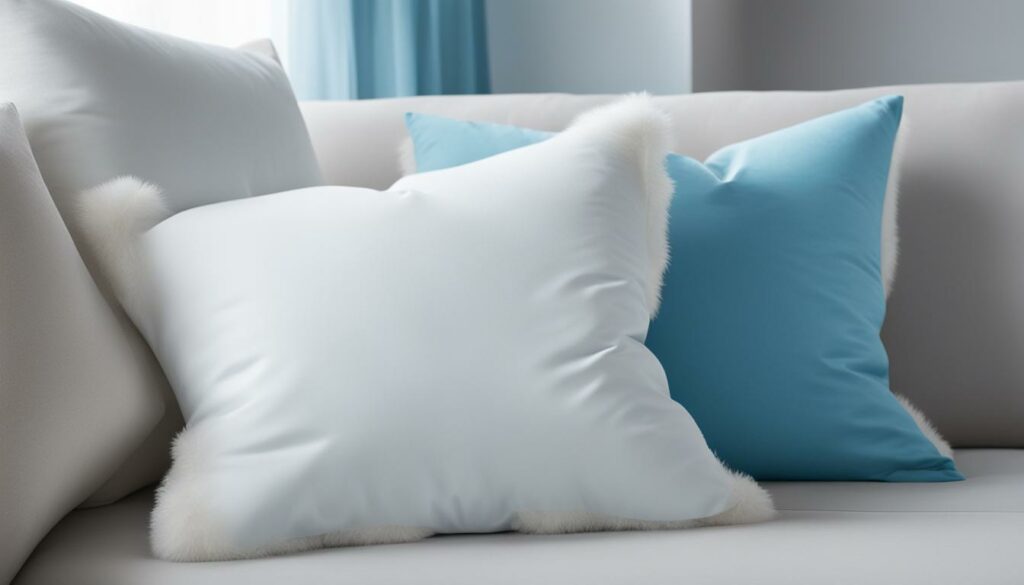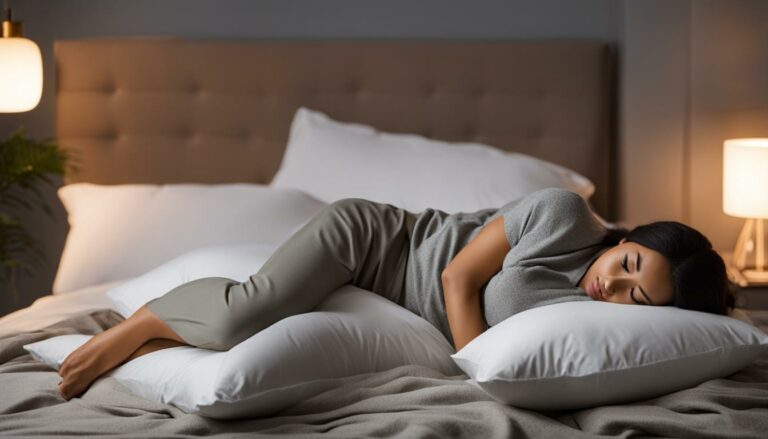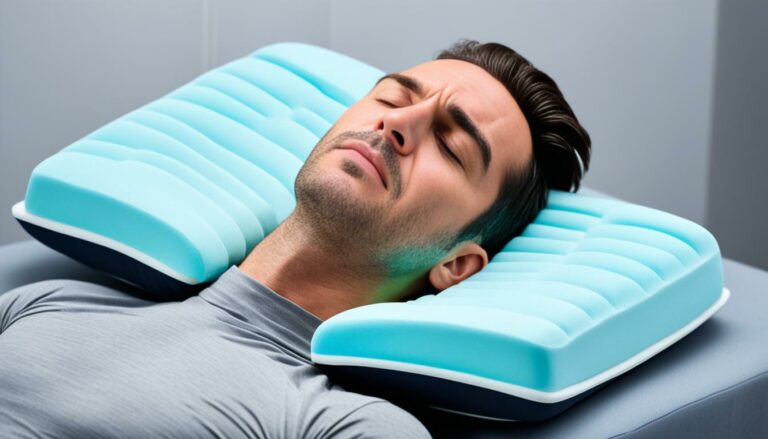Down Pillows & Allergies: What You Need to Know
Eric Christie stands as a luminary in the bedding industry, with a career spanning nearly four decades since the early 1980s. His journey through the world of bedding has seen him wear many hats – a manufacturer, designer, and retailer, showcasing his versatility and expertise in Read more...
pillowsandbedsheets.com and its partners may earn a commission if you purchase a product through one of our links
If you suffer from allergies, you know how important it is to create an allergy-free environment at home. Your bedding, including pillows, plays a crucial role in managing your allergies. But are down pillows bad for allergies? Can you find allergy-friendly options? Let’s explore.
Down pillows are not 100% hypoallergenic since they can harbor allergens such as dust mites and feathers. However, there are ways to make them more allergy-friendly. By taking a few simple steps, you can enjoy the comfort of down pillows while reducing allergen exposure and alleviating your allergy symptoms.
One effective way to make down pillows more allergy-friendly is by using pillow protectors. These covers act as a barrier, preventing allergens from coming into direct contact with your skin and respiratory system. Additionally, regularly changing your pillowcases and washing the pillows can help eliminate allergens and keep your pillows fresh.
It’s important to note that allergy sufferers should consider replacing their pillows more frequently compared to those without allergies. By doing so, you can ensure that your bedding remains clean and allergen-free, providing a healthier sleeping environment.
Key Takeaways:
- Down pillows are not 100% hypoallergenic, but there are ways to make them more allergy-friendly.
- Using pillow protectors can act as a barrier, reducing allergen exposure.
- Regularly changing pillowcases and washing pillows can help eliminate allergens.
- Allergy sufferers should consider replacing their pillows more frequently.
- Creating an allergy-free bedding environment is key to managing allergies.
Can Down and Feather Pillows Be Hypoallergenic?
When it comes to allergies, choosing the right bedding is essential for a restful night’s sleep. If you suffer from allergies, you may be wondering if down and feather pillows can be hypoallergenic. While they are not completely allergy-friendly, there is good news – you can still enjoy the comfort of down and feather pillows with some precautions.
Using Pillow Protectors for Allergy Prevention
To make down and feather pillows more hypoallergenic, consider using pillow protectors. These covers act as a barrier, preventing dust mites and allergens from penetrating the pillow. By enclosing the pillow in a protector, you can create a shield against potential irritants. It’s important to choose pillow protectors made from tightly woven fabrics like twill or satin, as they can keep allergens inside the pillow.
Frequent Washing for Dust and Allergen Removal
Regularly washing down and feather pillows can help eliminate dust and allergens, making them more hypoallergenic. Follow the manufacturer’s instructions for cleaning, or consult with a professional cleaner if necessary. Washing your pillows every few months (or more frequently, if recommended) can ensure they remain fresh and free from allergens.
Choose Tightly Woven Fabrics for Pillow Covers
In addition to using pillow protectors, opt for pillowcases made from tightly woven fabrics. These fabrics can help trap allergens and prevent them from escaping into the air while you sleep. Consider pillowcases made from materials like twill, satin, or other tightly woven natural fibers.
Pro Tip: Regularly washing pillowcases in hot water can further help kill dust mites and remove allergens.
While down and feather pillows are not completely hypoallergenic, following these precautions can help minimize allergic reactions and create a more comfortable sleeping environment. By using pillow protectors, washing pillows regularly, and selecting appropriate pillowcases, you can enjoy the luxurious feel of down and feather pillows without compromising your allergies.
Solutions for Feather Pillow Allergies
If you suffer from feather pillow allergies, don’t worry. There are alternative pillow options available that are hypoallergenic and can provide the comfort you need. Here are some options to consider:
Pillows made of Synthetic Materials
If you want to avoid feathers altogether, pillows made of synthetic materials like polyester or microfiber are a great choice. These pillows are hypoallergenic and do not contain any feathers, making them ideal for allergy sufferers.
Down Alternative Pillows
For those who love the luxurious feel of down but have allergies, down alternative pillows are the perfect solution. These pillows are made from synthetic fibers that mimic the feel of down, providing the same comfort without the risk of allergies.
100% Cotton Pillows
Another natural and hypoallergenic option is 100% cotton pillows. Cotton is naturally breathable and helps prevent the buildup of allergens. These pillows are not only hypoallergenic but also provide a cool and comfortable sleep experience.
Memory Foam Pillows
If you prefer a contouring and supportive pillow, memory foam pillows are a great choice. Made from dense, heat-sensitive material, memory foam pillows mold to the shape of your head and neck, providing personalized comfort. They are also hypoallergenic, making them suitable for allergy sufferers.
Remember, when choosing a pillow for your feather pillow allergies, it’s important to consider your specific needs and preferences. Here’s a comparison table of the different pillow options:
| Pillow Type | Material | Hypoallergenic | Comfort |
|---|---|---|---|
| Synthetic Materials | Polyester or Microfiber | Yes | Moderate |
| Down Alternative | Synthetic fibers | Yes | Similar to Down |
| 100% Cotton | Cotton | Yes | Breathable |
| Memory Foam | Dense, heat-sensitive material | Yes | Contouring and supportive |
As you can see, each pillow type has its own unique benefits. Whether you prefer the softness of synthetic materials, the luxury of down alternative, the natural breathability of cotton, or the support of memory foam, there is a pillow option that suits your needs.

By choosing the right pillow for your feather pillow allergies, you can enjoy a good night’s sleep without any discomfort or allergic reactions.
The Importance of Pillow Protectors for Allergies
Pillow protectors are an essential tool for allergy sufferers. They act as a barrier between your pillow and you, reducing your exposure to allergens and creating a healthier sleep environment. By using hypoallergenic materials such as microfiber or cotton for your pillow protectors, you can further prevent allergens from penetrating and ensure a more restful night’s sleep.
With pillow protectors, not only do you safeguard yourself from allergens, but you also extend the lifespan of your pillow. Protecting your pillow from sweat, oils, and stains can prevent premature wear and tear and maintain its overall quality for longer.
For those with severe allergies, using two pillow protectors is recommended for an extra layer of protection. This additional barrier can offer extra peace of mind and minimize the potential for allergens to disrupt your sleep.
Investing in high-quality pillow protectors is a small step that can yield significant benefits for your health and well-being.
The Benefits of Pillow Protectors:
- Reduced exposure to allergens, such as dust mites and pet dander
- Protection against sweat, oils, and stains, prolonging the life of your pillow
- Easy to clean and maintain
- Enhanced comfort and breathability
Choosing the Right Pillow Protector:
When selecting a pillow protector, consider the material that best suits your needs. Microfiber and cotton are popular choices for their hypoallergenic properties and breathability. Additionally, they provide a soft and comfortable sleep surface.
Microfiber pillow protectors are tightly woven, preventing even the smallest allergens from passing through. They are also resistant to dust mites, making them an excellent option for allergy sufferers.
Cotton pillow protectors are naturally hypoallergenic and gentle on the skin. Their breathable nature keeps you cool throughout the night, promoting optimal sleep conditions.
Don’t Forget to Wash Your Pillow Protectors!
Regularly washing your pillow protectors is vital to maintain their effectiveness. They should be laundered alongside your bedding on a regular basis. It’s recommended to follow the care instructions provided by the manufacturer to ensure proper cleaning methods and to prolong the life of your pillow protectors.
By prioritizing the use of pillow protectors and incorporating them into your bedding routine, you can create a cleaner, healthier sleep environment and wake up feeling refreshed and free from allergy symptoms.

Washing Pillows to Reduce Allergens
Allergy sufferers know the importance of maintaining clean and allergen-free bedding, and washing pillows regularly is an essential part of pillow maintenance. Regular washing not only helps to eliminate dust mites but also removes allergens that can trigger allergic reactions. Follow these tips to wash your pillows effectively and reduce allergens:
- Check the care label: Before washing your pillows, always review the care label for specific instructions on cleaning. Some pillows may have special requirements, such as dry cleaning only.
- Choose hot water: Dust mites are microscopic pests that thrive in warm and humid environments. To kill these allergens effectively, wash your pillows in hot water (above 130°F or 54°C).
- Use mild detergent: When washing your pillows, use a hypoallergenic or mild detergent. Avoid harsh chemicals or bleach, as they can damage the pillow fibers and cause skin irritations.
- Consider pillow type: Different types of pillows require different washing methods. Synthetic pillows, like polyester or microfiber, can withstand machine washing. Feather pillows, on the other hand, may require delicate care or even professional cleaning.
- Dry thoroughly: After washing, make sure to dry your pillows thoroughly to prevent mold or mildew growth. Use a low heat setting in the dryer or air-dry them in a well-ventilated area.
Regularly washing pillows in hot water can help kill dust mites and remove allergens. It is important to follow proper pillow washing instructions to ensure effectiveness.
By incorporating regular pillow washing into your bedding routine, you can create a cleaner and more allergy-friendly environment for a restful sleep.
Comparing Pillow Washing Methods
| Pillow Type | Recommended Washing Method |
|---|---|
| Synthetic Pillows | Machine wash in hot water with mild detergent. Dry thoroughly. |
| Feather Pillows | Hand wash or use a delicate cycle with mild detergent. Air dry or tumble dry with low heat. |
| Memory Foam Pillows | Spot clean with mild detergent and warm water. Do not soak or machine wash. |
| Down Alternative Pillows | Machine wash in warm water with mild detergent. Tumble dry low. |

Proper pillow washing not only helps to eliminate allergens but also extends the lifespan of your pillows. By following the correct washing methods for different pillow types, you can keep your pillows fresh and clean, ensuring a healthier sleep environment.
Air Out Your Feather Pillows
When it comes to keeping your feather pillows fresh and reducing allergens, a simple yet effective solution is to air them out regularly. By taking your pillows outside for a few hours each week, you can help eliminate unpleasant odors and minimize the buildup of allergens.
Airing out your feather pillows allows them to breathe and release any trapped moisture or odor. This practice can significantly improve the overall freshness of your pillows and make them more enjoyable to sleep on. Furthermore, the exposure to fresh air can help reduce the presence of allergens that may have accumulated over time.
To air out your feather pillows successfully, follow these steps:
- Choose a dry and sunny day: Pick a day with good weather conditions, preferably when the sun is shining, since sunlight has natural disinfecting properties.
- Find a clean, open space: Locate an area in your yard or balcony where you can spread out your pillows without them touching the ground. This will help avoid any dirt or dust getting onto the pillows.
- Place the pillows flat: Lay your feather pillows flat on a clean surface, ensuring they have enough space to breathe and air out properly.
- Leave them outside for a few hours: Let the fresh air do its work by leaving your pillows outside for at least 2-4 hours. During this time, the natural ventilation will help remove any stale odors and allergens from the pillow filling.
- Bring them back inside: Once the pillows have been adequately aired out, bring them back inside and prepare them for use. Ensure they are fully dry before putting them back on your bed.
By incorporating this simple practice into your pillow care routine, you can enjoy refreshed and allergen-controlled feather pillows.

Airing out your feather pillows is a cost-effective and natural way to maintain their freshness while reducing the presence of allergens. Make it a habit to periodically bring your pillows outside for a breath of fresh air, and you’ll appreciate the difference it makes in the quality of your sleep.
Using Humidifiers for Feather Pillow Allergies
If you suffer from allergies caused by feather pillows, incorporating a humidifier into your bedroom can provide relief. By maintaining a proper level of moisture in the air, humidifiers can help alleviate allergy symptoms associated with feather pillows.
When the air in your room is too dry, it can further irritate your respiratory system and exacerbate allergy symptoms. Dry air can also cause nasal passages to become congested and dry, making it harder to breathe comfortably.
Humidifiers work by adding moisture to the air, creating a more humid environment in your bedroom. This moist air can help soothe your respiratory system and reduce irritation caused by feather pillow allergies.
When using a humidifier, it is important to keep it clean and properly maintained to prevent the growth of mold or bacteria. Regularly clean and disinfect your humidifier according to the manufacturer’s instructions to ensure optimal performance and hygiene.
To maximize the benefits of a humidifier for feather pillow allergies, consider the following tips:
1. Choose the right humidifier:
There are various types of humidifiers available, including cool mist and warm mist humidifiers. Consider your specific needs and preferences when selecting a humidifier for your bedroom. Cool mist humidifiers are generally recommended for allergy sufferers as they don’t produce hot water vapor, which can potentially worsen respiratory symptoms.
2. Maintain proper humidity levels:
Aim for a humidity level between 30% and 50% in your bedroom. Using a hygrometer, a device that measures humidity, can help you monitor and adjust the humidity levels accordingly.
3. Clean and change water regularly:
Clean your humidifier regularly and replace the water daily to prevent the growth of mold or bacteria. Follow the manufacturer’s instructions for proper cleaning and maintenance.
“A humidifier can help alleviate allergy symptoms by maintaining a moist environment in your bedroom, reducing respiratory irritation caused by feather pillows.”
Consultation with a Doctor for Severe Allergies
If you have been experiencing severe allergies despite taking preventive measures, it is crucial to seek a consultation with a doctor. While there are various ways to manage allergies at home, a medical professional can provide expert guidance and offer additional treatment options to alleviate your symptoms and improve your quality of life.
Consulting with a doctor is particularly essential for individuals with severe allergies, as there may be underlying medical conditions contributing to the severity of your allergic reactions.
Your doctor will conduct a thorough evaluation and may recommend diagnostic tests to identify the specific allergens triggering your symptoms. Based on the results, they can develop a personalized treatment plan that may include medication, immunotherapy, or other interventions to help manage your allergies effectively.
Additionally, consulting with a doctor is vital if your allergies are interfering with your daily activities, affecting your sleep, or impacting your overall well-being. They can provide medical advice tailored to your specific circumstances and help address any concerns or questions you may have.
“A consultation with a doctor is crucial for individuals with severe allergies, as they can provide personalized treatment options and help identify any underlying medical conditions contributing to the severity of symptoms.”
Remember, each person’s allergies and medical history are unique, so it’s essential to discuss your symptoms and concerns with a healthcare professional who can provide individualized care. They will work collaboratively with you to develop a comprehensive management plan and offer ongoing support to help you live comfortably with your allergies.
Don’t delay seeking medical attention if you are experiencing severe allergy symptoms. Consult with a doctor today to explore the appropriate medical treatment and address any underlying conditions that may be contributing to your allergies.
Take proactive steps towards managing your allergies by making an appointment with a qualified healthcare professional.
| Key Points to Consider: |
|---|
| Consult with a doctor if allergy symptoms persist despite preventive measures. |
| A doctor can provide expert guidance and treatment options. |
| There may be underlying medical conditions contributing to severe allergies. |
| Individualized treatment plans can help manage allergies effectively. |
| Seek medical attention if allergies significantly affect your daily life. |
The Importance of Pillowcases for Allergies
Pillowcases are an essential component of allergy protection. They serve as a barrier between your pillow and you, preventing direct contact with allergens such as dust mites. By using pillowcases, you can create a clean and hygienic sleeping environment that reduces the risk of allergen exposure.
For individuals who use feather pillows, the choice of pillowcase becomes even more crucial. Feather pillows, while comfortable, can harbor more dust mites and allergens compared to other types of pillows. Therefore, it is recommended to use pillowcases with zippered enclosures for added protection against these microscopic irritants.
The zippered cases provide an extra layer of defense, preventing dust mites from infiltrating your pillow and coming into contact with your skin or airways. This can be particularly beneficial for individuals who suffer from allergies or asthma, as it helps minimize the symptoms commonly associated with dust mite exposure.
Benefits of using zippered pillowcases:
- Complete coverage: The zippered closure ensures that your pillow is fully enclosed, leaving no gaps for allergens to enter.
- Easy maintenance: Zippered pillowcases are simple to remove and wash, allowing for regular cleaning to eliminate allergens.
- Durable protection: The sturdy zippered design ensures long-lasting protection and reduces the risk of allergen buildup over time.
By investing in zippered pillowcases, you can enhance your allergy protection and create a healthier sleep environment. Remember to wash your pillowcases regularly and follow the manufacturer’s instructions for proper care to maintain their effectiveness.
Choosing Hypoallergenic Pillows
When it comes to finding the perfect pillows for allergy sufferers, opting for hypoallergenic options is crucial. These allergy-friendly pillows are designed to minimize the risk of allergens triggering a reaction, allowing you to enjoy a comfortable and restful sleep.
But which materials should you consider for hypoallergenic pillows? Let’s explore:
Natural Materials for Allergy-Friendly Pillows
Choosing pillows made from natural materials can be a great solution for those prone to allergies. Natural materials like feathers, wool, and cotton are less likely to cause allergic reactions compared to synthetic options.
Feather pillows, for example, are known for their softness and cushioning support. They provide a luxurious feel and are naturally hypoallergenic when properly cleaned and maintained.
Wool pillows offer excellent temperature regulation and durability, making them a popular choice among allergy sufferers. The natural fibers of wool are resistant to dust mites and mold, providing a clean and breathable sleeping environment.
Cotton pillows, on the other hand, are breathable and gentle on the skin. With their hypoallergenic properties, they can help reduce the risk of allergies and provide a comfortable sleep surface.
Synthetic Materials to Avoid
While natural materials are recommended for hypoallergenic pillows, it’s important to be aware of synthetic materials that may trigger allergies. Polyester and memory foam, for example, are commonly used in pillows but can be more likely to cause allergic reactions.
Polyester pillows, although affordable and easy to care for, may harbor dust mites and other allergens. Similarly, memory foam pillows, while offering excellent support and pressure relief, can potentially emit volatile organic compounds (VOCs) that may irritate sensitive individuals.
To ensure a truly hypoallergenic sleeping experience, it’s best to steer clear of synthetic materials and opt for pillows made from natural fibers.
| Pillow Material | Benefits | Considerations |
|---|---|---|
| Feathers | – Soft and luxurious | – Requires regular cleaning and maintenance |
| Wool | – Temperature regulation – Resistant to dust mites and mold |
– May feel dense or heavy for some individuals |
| Cotton | – Breathable and gentle on the skin | – May flatten over time |
| Polyester | – Affordable and easy to care for | – May harbor dust mites and allergens |
| Memory Foam | – Excellent support and pressure relief | – Potential off-gassing of VOCs |
When selecting your hypoallergenic pillows, it’s essential to consider your personal preferences and any specific allergy concerns you may have. Remember to regularly clean and maintain your pillows to ensure optimal cleanliness and allergen reduction.
Preventing Pillow Allergies
While it may not be possible to completely prevent pillow allergies, there are steps that you can take to reduce the risk and minimize exposure to allergens.
First and foremost, choose pillows made from natural materials. Natural materials like feathers, wool, and cotton are less likely to cause allergic reactions compared to synthetic materials. These natural fibers allow for better breathability and are less prone to trapping allergens.
It is also important to avoid using second-hand pillows whenever possible. Second-hand pillows may harbor dust mites, mold, and other allergens that can trigger allergies. Opt for new pillows instead to ensure a clean and allergen-free sleeping environment.
Regularly washing pillowcases is another key step in preventing pillow allergies. Pillowcases can accumulate dust mites, pollen, and other allergens over time. Make it a habit to wash your pillowcases at least once a week using hot water to kill any allergens that may be present. This simple practice can greatly reduce the risk of allergic reactions.
FAQ
Can down pillows cause allergies?
Down pillows are not 100% hypoallergenic, but there are ways to make them more allergy-friendly. Using pillow protectors, changing pillowcases regularly, washing pillows frequently, and using tightly woven fabric can help reduce allergens. It is also recommended for allergy sufferers to replace pillows more frequently than non-allergy sufferers.
Can feather pillows be hypoallergenic?
While down and feather pillows are not completely hypoallergenic, they can still be enjoyed by allergy sufferers with some precautions. Using pillow protectors and changing them regularly can help keep the pillow hypoallergenic. Washing pillows frequently can also remove dust and allergens. It is recommended to use tightly woven fabrics like twill or satin to keep allergens inside the pillow.
What are the alternative pillow options for feather pillow allergies?
For those with feather pillow allergies, there are alternative pillow options available. Pillows made of synthetic materials like polyester or microfiber are hypoallergenic and do not contain feathers. Down alternative pillows, made from synthetic fibers that mimic the feel of down, can provide similar comfort. 100% cotton pillows are naturally hypoallergenic and breathable. Memory foam pillows, made of a dense, heat-sensitive material, can mold to the shape of the head and neck.
How do pillow protectors help with allergies?
Pillow protectors are an essential tool for allergy sufferers. They act as a barrier between the pillow and the sleeper, reducing exposure to allergens. Using hypoallergenic materials like microfiber or cotton for pillow protectors can further prevent allergens from penetrating. For those with severe allergies, using two pillow protectors is recommended.
How often should you wash pillows to reduce allergens?
Regularly washing pillows in hot water can help kill dust mites and remove allergens. It is important to follow proper pillow washing instructions to ensure effectiveness. Dust mites tend to accumulate more on synthetic pillows than feather pillows, so allergy sufferers should consider washing their pillows more frequently.
How can you reduce allergens in feather pillows?
Airing out feather pillows outside for a few hours each week can help reduce odor and allergens. This practice can help keep the pillow fresh and free from accumulated allergens.
Can humidifiers help with feather pillow allergies?
Using a humidifier in the bedroom can help keep the air moist, which can alleviate allergy symptoms caused by feather pillows. Moist air can help reduce irritation and soothe the respiratory system.
What should you do if allergy symptoms persist?
If allergy symptoms persist despite preventive measures, it is important to consult with a doctor. A doctor can provide further guidance and treatment options, as there may be underlying medical conditions contributing to the allergies.
How do pillowcases protect against allergies?
Pillowcases play a crucial role in allergy protection. They act as a barrier between the pillow and the sleeper, preventing contact with allergens. Using pillowcases with zippers can provide extra protection, especially for those using feather pillows.
What are the best hypoallergenic pillow options?
When looking for allergy-friendly pillows, it is recommended to choose pillows made from natural materials like feathers, wool, or cotton. These materials are less likely to cause allergic reactions. Synthetic materials like polyester and memory foam, on the other hand, are more likely to trigger allergies.
How can you prevent pillow allergies?
While it may not be possible to completely prevent pillow allergies, there are steps that can be taken to reduce the risk. Choosing pillows made from natural materials, avoiding second-hand pillows, and regularly washing pillowcases can help minimize exposure to allergens.
Eric Christie stands as a luminary in the bedding industry, with a career spanning nearly four decades since the early 1980s. His journey through the world of bedding has seen him wear many hats – a manufacturer, designer, and retailer, showcasing his versatility and expertise in Read more...







